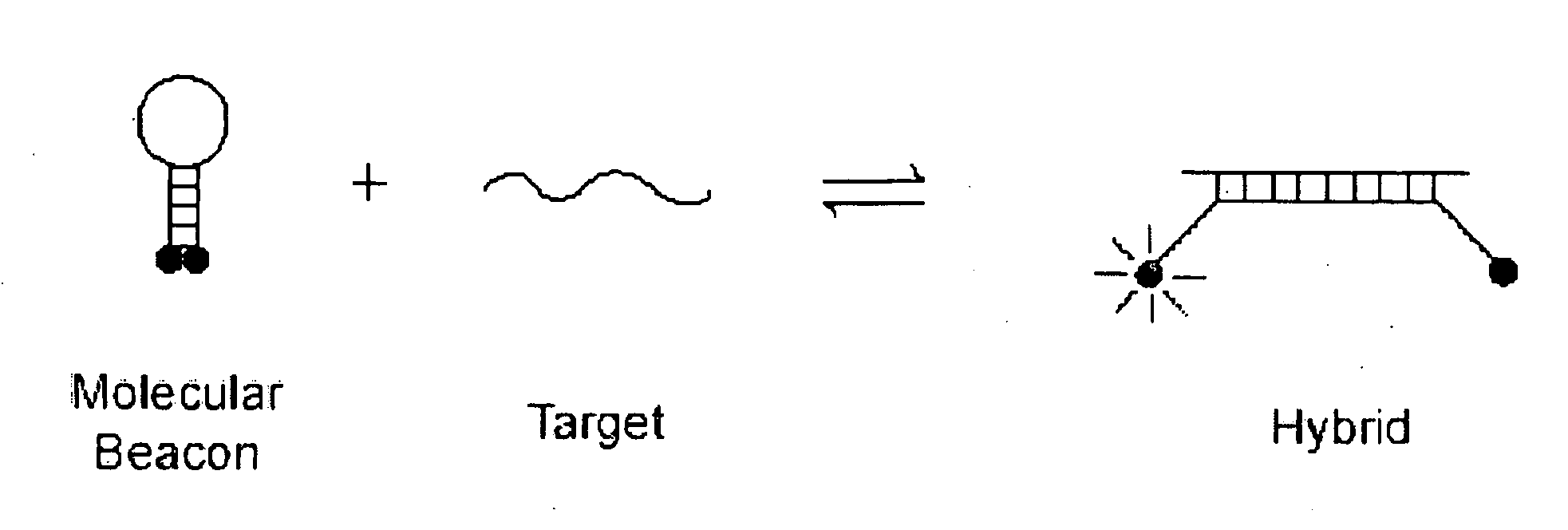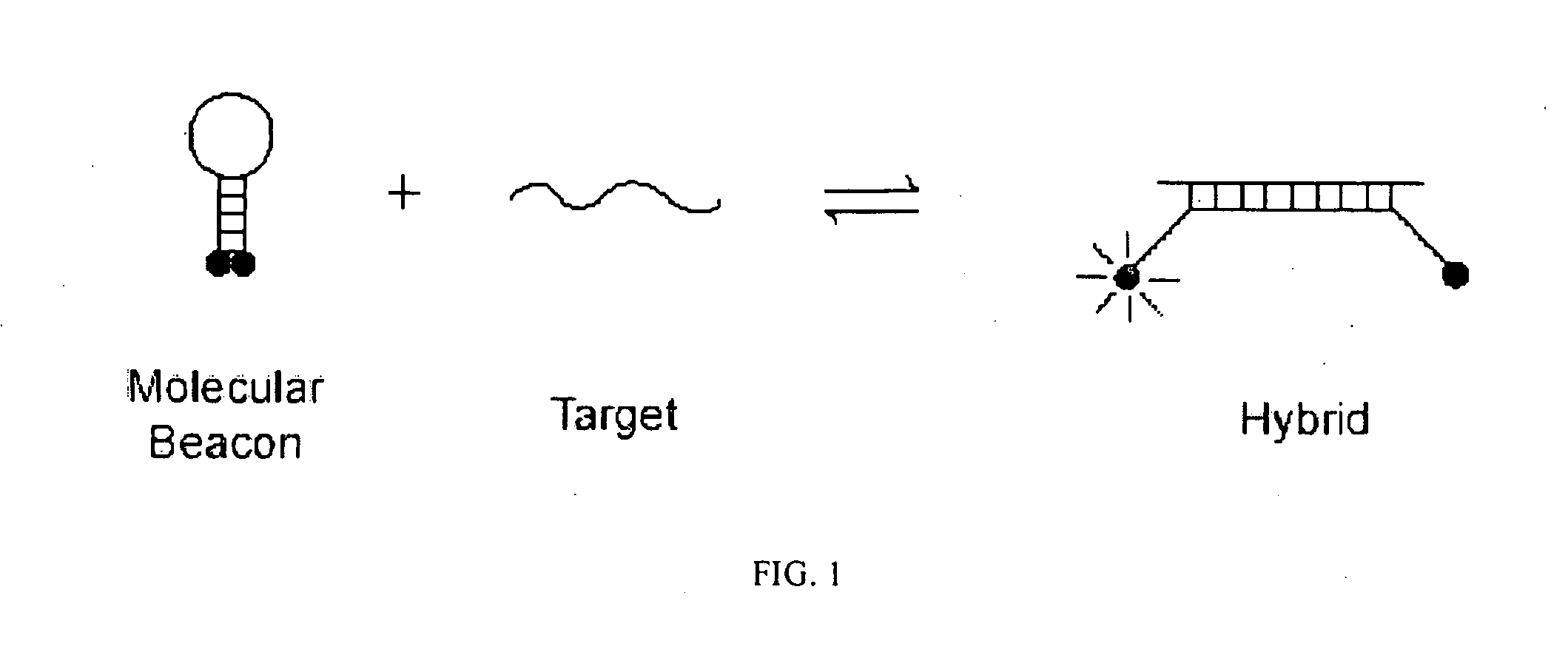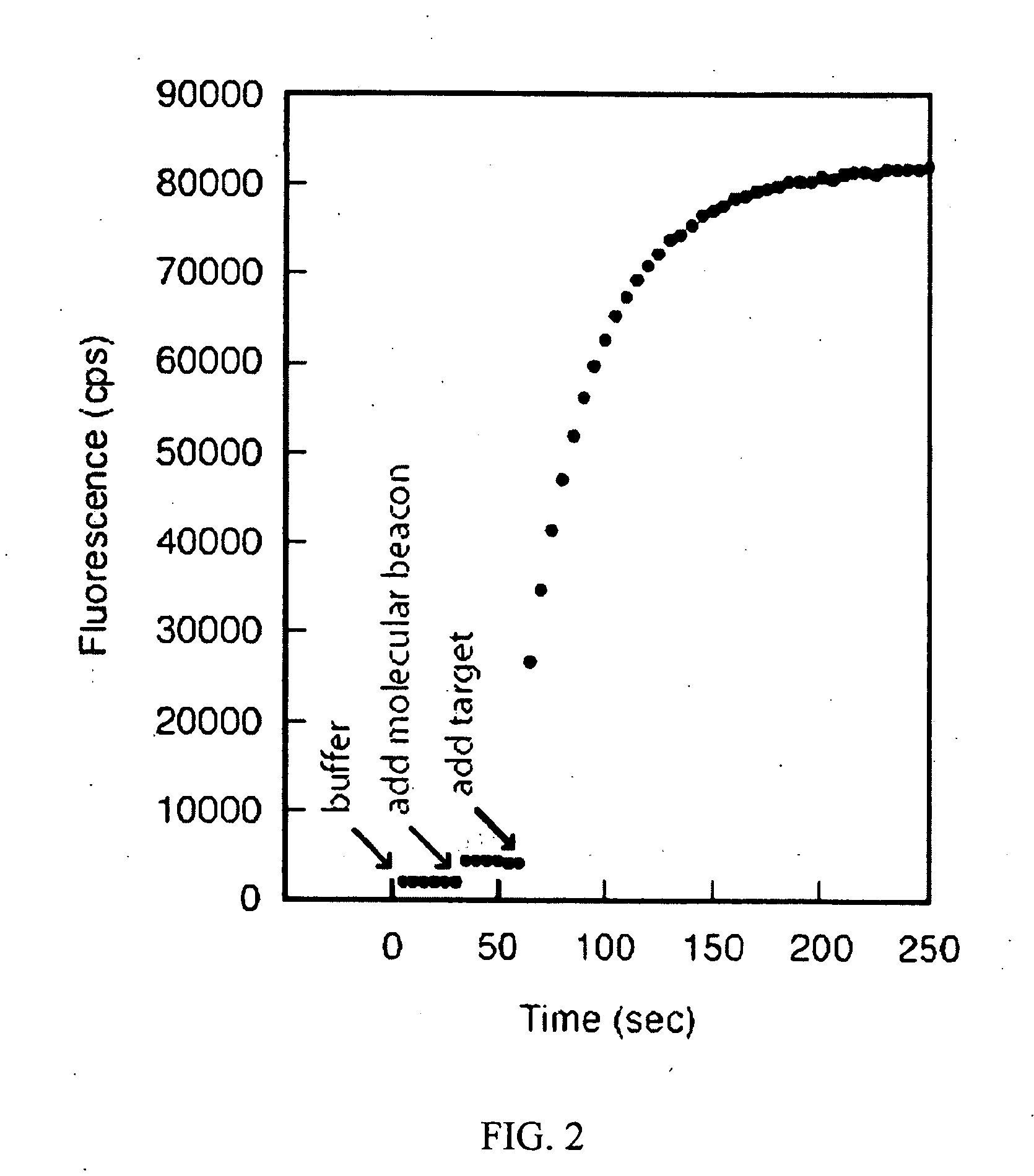Bimolecular Constructs
a bimolecular and construct technology, applied in the field of target-binding bimolecular constructs, can solve the problems of disadvantage, dissimilarity of instant bimolecular constructs with instant bimolecular constructs, and dissimilarity of monomolecular nucleic acid-based detection constructs such as molecular beacons
- Summary
- Abstract
- Description
- Claims
- Application Information
AI Technical Summary
Benefits of technology
Problems solved by technology
Method used
Image
Examples
example 1
Bimolecular Probes for Nucleic Acid Detection in Solution
[0049]A fluorescein labeled hairpin DNA Oligonucleotide, HP2, with a ten base-pair linker sequence was machine synthesized and HPLC purified. The sequence of HP2 was:
5′ FAM - CGTCG ACC ATG ATC GGC GGC CGACG CTGTGCTCGC - 3′
The underlined stretches in this sequence represent arm sequences that form the stem structure of the hairpin in the absence of complementary nucleic acid target. An anchor-oligo sequence representing the linear complement to the ten base-pair linker sequence of HP2 was also synthesized and HPLC purified. The sequence of this anchor-oligo was:
5′ - GCG AGC ACA G - BHQ2 - 3′
Finally, the target oligonucleotide complementary to the loop region of HP2 was synthesized and purified. The target oligo sequence was:
5′ - GCC GCC GAT CAT GGT - 3′
The fluorescence background of 150 μl of a 1 mM MgCl2, 20 mM Tris-HCl, pH 8.0 solution was determined, using 491 nm as the excitation wavelength and 515 as the emission wavelengt...
example 2
Bimolecular 2′O-Methyl Probe for Detection of Complementary microRNA
[0050]A Dabcyl labeled 2′O-methyl hairpin oligonucleotide, HP3, with a ten base-pair linker sequence was machine synthesized and HPLC purified. The sequence of HP3 was:
5′ CUG CUA CGU G -CUCG AC CAC ACA ACCCGAG -DABCYL 3′
The underlined stretches in this sequence represent arm sequences that form the stem structure of the hairpin in the absence of complementary nucleic acid target. A 2′O-methyl anchor-oligo sequence representing the linear complement to the ten base-pair linker sequence of HP3 was also synthesized and HPLC purified. The sequence of this anchor-oligo was:
5′ - FAM-CAC GUA GCA G - 3′
Finally, a target RNA sequence corresponding to the let7b miRNA was synthesized. The let7b sequence was fully complementary to the loop sequence in HP3.
The interaction of FAM-labeled anchor oligo with the Dabcyl-labeled let7b probe gives a decrease in fluorescence as hairpin formation brings the FAM and Dabcyl groups into nea...
example 3
Bimolecular 2′O-Methyl Probe for Single Base Pair Discrimination of MicroRNA
[0051]A Dabcyl labeled 2′O-methyl hairpin oligonucleotide, HP3, with a ten base-pair linker sequence was machine synthesized and HPLC purified. The sequence of HP3 was:
5′ CUG CUA CGU G -CUCG AC CAC ACA ACCCGAG -DABCYL 3′
The underlined stretches in this sequence represent arm sequences that form the stem structure of the hairpin in the absence of complementary nucleic acid target. A 2′O-methyl anchor-oligo sequence representing the linear complement to the ten base-pair linker sequence of HP3 was also synthesized and HPLC purified. The sequence of this anchor-oligo was:
5′ - FAM-CAC GUA GCA G - 3′
Finally, RNA sequences corresponding to the miRNAs let7a, let7b, let7c and let7f were synthesized. The let7b sequence was fully complementary to the loop sequence in HP3. The target oligo sequences were:
Let7a:5′ U GAG GUA GUA GGU UGU AUA GUU 3′Let7b:5′ U GAG GUA GUA GGU UGU GUG GUU 3′Let7c:5′ U GAG GUA GUA GGU UGU AUG...
PUM
 Login to View More
Login to View More Abstract
Description
Claims
Application Information
 Login to View More
Login to View More - R&D
- Intellectual Property
- Life Sciences
- Materials
- Tech Scout
- Unparalleled Data Quality
- Higher Quality Content
- 60% Fewer Hallucinations
Browse by: Latest US Patents, China's latest patents, Technical Efficacy Thesaurus, Application Domain, Technology Topic, Popular Technical Reports.
© 2025 PatSnap. All rights reserved.Legal|Privacy policy|Modern Slavery Act Transparency Statement|Sitemap|About US| Contact US: help@patsnap.com



